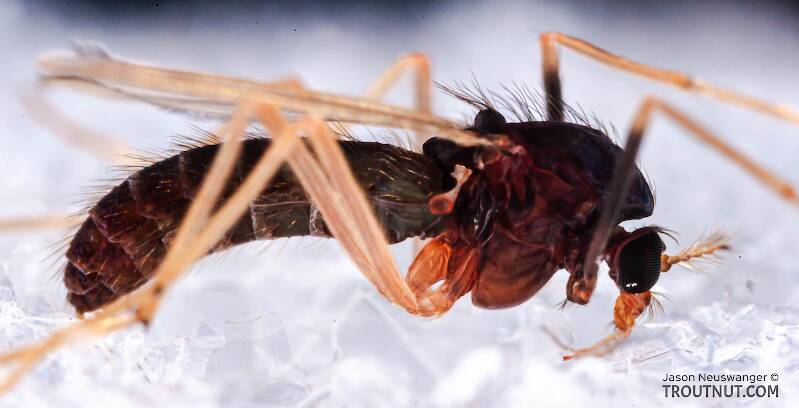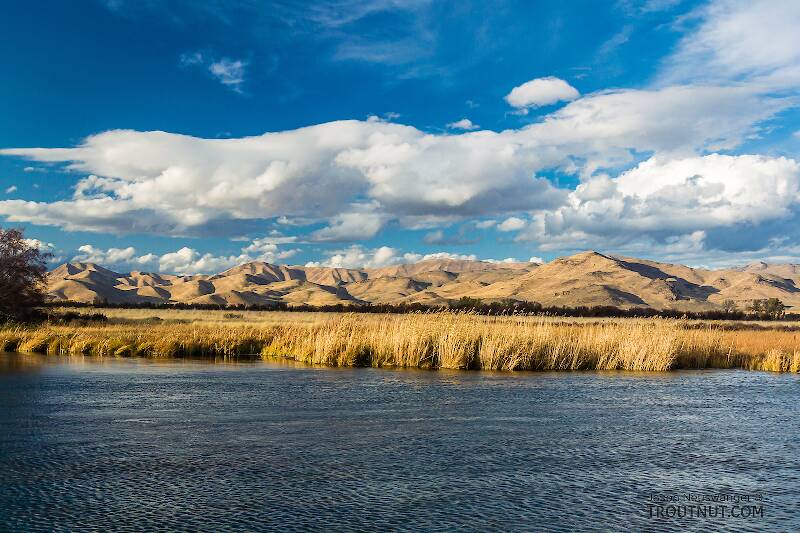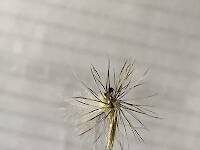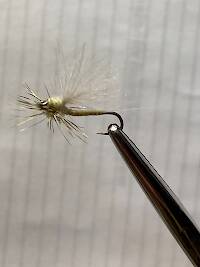
Salmonflies
Pteronarcys californica
The giant Salmonflies of the Western mountains are legendary for their proclivity to elicit consistent dry-fly action and ferocious strikes.
Featured on the forum

This one pretty clearly keys to Kogotus, but it also looks fairly different from specimens I caught in the same creek about a month later in the year. With only one species of the genus known in Washington, I'm not sure about the answer to this ID.

Troutnut is a project started in 2003 by salmonid ecologist Jason "Troutnut" Neuswanger to help anglers and
fly tyers unabashedly embrace the entomological side of the sport. Learn more about Troutnut or
support the project for an enhanced experience here.

One of the only real benefits I've got from my rearing aquarium so far is that I've had quite a variety of midges emerge, giving me a chance to photograph these fragile little insects which are otherwise really hard to transport in photogenic form. This one recovered from being gassed and flew away before I could photograph it on the ruler, but it was very small, around 1.5mm.
Gatruk
Posts: 1
Posts: 1
Gatruk on Jan 29, 2010January 29th, 2010, 9:19 am EST
I am searching to find effective ways of cultivating chronomidaes, what kind of best cheap an effective medium that I should use , what are there lifecycles . lifespans an their behaviors. Thanks for letting me to join the forum.
Taxon on Jan 29, 2010January 29th, 2010, 3:59 pm EST
Gatruk-
Chironomids (members of true fly family Chironomidae) are a diverse group numbering ~1233 identified North American species, and still counting. They are found in most waters, from sewage treatment ponds to mountain streams, and everything in between. However, attempts to propagate chironomids have been largely unsuccessful, mostly owing to the inability to induce swarming and mating of chironomid adults in captivity. In other words, you can lead them to water, but you can't make them ..... Hmm, bad joke, that. Anyway, for more information, see this article.
Chironomids (members of true fly family Chironomidae) are a diverse group numbering ~1233 identified North American species, and still counting. They are found in most waters, from sewage treatment ponds to mountain streams, and everything in between. However, attempts to propagate chironomids have been largely unsuccessful, mostly owing to the inability to induce swarming and mating of chironomid adults in captivity. In other words, you can lead them to water, but you can't make them ..... Hmm, bad joke, that. Anyway, for more information, see this article.
Martinlf on Jan 30, 2010January 30th, 2010, 8:43 am EST
Just the kind of joke I'd expect from you Roger. ;> But with that one-liner you did leave yourself open, knowing I'd be lurking.
Oh, now I get it; this was a setup. You got your buddy Gatruk to post the chromomidae question, so you could reply, and here I am stepping into the trap.
But, I must admit, I kinda liked the joke.
Oh, now I get it; this was a setup. You got your buddy Gatruk to post the chromomidae question, so you could reply, and here I am stepping into the trap.
But, I must admit, I kinda liked the joke.
"He spread them a yard and a half. 'And every one that got away is this big.'"
--Fred Chappell
--Fred Chappell
Taxon on Jan 30, 2010January 30th, 2010, 12:07 pm EST
Hi Louis-
Wouldn't want to disappoint you.
Best regards,
Wouldn't want to disappoint you.
Best regards,
Quick Reply
Related Discussions
Topic
Replies
Last Reply
5
Jun 22, 2012
by Falsifly
by Falsifly
3
Mar 9, 2014
by Entoman
by Entoman
40
Dec 12, 2011
by Keystoner
by Keystoner
3
Aug 12, 2012
by Taxon
by Taxon





